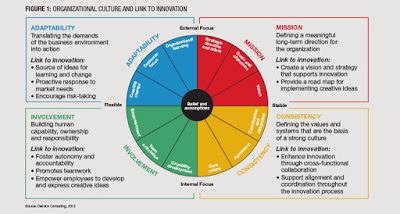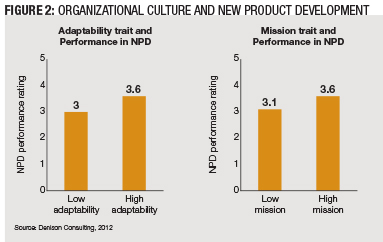Culture drives innovation. From Apple’s startup culture to 3M’s culture of out-of-the-box thinking to Samsung Electronics’ culture of strong support for risk-taking, there are many examples of how unique organizational cultures have driven successful innovations. Despite these and many other cases, managers and leaders often focus on organizational structure, job characteristics, management processes and capital as the main drivers of innovation. However, recent studies suggest that organizational culture is the strongest driver of all and is perhaps a root source influencing many of the factors that have a more visible effect on innovation outcomes.
Organizational culture refers to the underlying values, beliefs and principles that serve as a foundation for an organization’s management system as well as the management practices and behaviors that exemplify and reinforce those principles. While organizational culture encompasses various elements, high-performing organizations have certain elements in common.
The Denison Organizational Culture Model includes four essential traits — mission, consistency, involvement and adaptability — of high-performance organizational culture. Studies by Denison Consulting — an organizational culture and leadership development consulting firm — have shown that these traits are important for organizational performance. Company consultants hypothesized that each trait would be important for innovation.
Three studies were conducted — the results from which were published in 2012 — using the Denison Organizational Culture Survey developed based on the model in Figure 1. High scores indicate a high level of clarity and alignment related to elements of organizational culture, whereas low scores indicate that cultural capabilities are not well developed in the organization.

Exploring the Culture-Innovation Link
The three studies included 294,197 employees from 664 organizations, and the data was gathered during the past 12 years. The culture survey was used to assess organizational culture in all three studies and captured different aspects of innovation for each study. They measured innovation based on employee ratings of the organization’s performance in new product development and innovation effectiveness and by using market growth assumptions retrieved from Standard & Poor’s Compustat database.
Overall, there are strong positive effects from adaptability, mission and involvement on innovation outcomes. First, when it comes to new product development, performance was significantly higher for organizations with a highly adaptive and mission-oriented culture. The regression analysis showed that organizational culture explained about 23 percent of the variability in new product development performance, and that adaptability was the single most important predictor followed by mission (Figure 2).

The study also measured innovation effectiveness in terms of creativity and successful implementation of creative ideas. The regression analysis showed that about 84 percent of the variance of innovation effectiveness could be explained by organizational culture (Figure 3). While all four culture traits contributed to this finding, results pointed to the importance of adaptability and mission as strong cultural innovation drivers. Involvement emerged as a third factor, suggesting that organizations can enhance innovation by empowering and developing their people.

The last indicator of innovation effectiveness is market growth assumptions. On average, market growth assumptions were significantly higher for organizations with high scores on all four cultural traits. As with the previous studies, additional analysis supported mission, adaptability and involvement as the primary drivers of innovation indexed by this metric.
Having a clear strategy that aligns people with the larger organizational goals and being nimble and fluid enough to respond to opportunities in the marketplace when they arise are key sources of innovative advantage for an organization.
Another source of organizational advantage can be found in the power of employee involvement. When employees are empowered, work in teams and are given opportunities to develop their capabilities, they are more likely to generate and express new ideas.
Further, in a highly consistent organization, there is a strong culture and a clear agreement on the do’s and don’ts. Given that consistency reflects the organization’s capability to perform in a steady and predictable manner over time, too much consistency can be detrimental to innovation, particularly when organizations lack clear capabilities in other areas. For example, if an organization is replicating its internal processes without a clear understanding of what customers want and the corresponding capabilities needed to support change, the organization is very likely to produce the same results rather than innovate.
The Styles of Innovation
An innovative culture is not a one-type-fits-all approach. Denison research identified three styles of innovation culture.
Customer-driven innovation: Innovative organizations are adaptable. With an outward focus, they quickly respond to customers and competitors, value risk-taking and act on the type of innovations the customer values. To build a customer-driven innovation culture:
• Listen to customers and find new ways to collaborate with them.
• Let outsiders bring new ideas. They can do this in a way that insiders cannot.
• Enhance organizational learning by rewarding educated risk-taking and supporting learning forums. Consider failures important sources of learning.
Vision-driven innovation: Having a clear vision allows for new idea development aligned with the direction in which the organization is moving. For instance, innovations at Apple have been largely driven by its strong vision rather than customer ideas. To develop a vision-driven innovation culture:
• Make it the highest priority to adopt long-term strategy and direction. Think of issues with a longer time horizon.
• Engage employees in defining the organization’s mission and vision.
• Help employees define their own goals aligned with the organizational mission, vision and strategy.
Involvement-driven innovation: Involvement matters to creativity, an important component of innovation. Organizations driving innovation through highly involved employees invest in their employees, promote empowerment and facilitate teamwork. They ensure freedom and capability to develop new ideas. To foster innovation through involvement:
• Give employees resources and opportunities to be creative. For example, a prescribed innovation timeout can be great for employees to play with new ideas.
• Promote teamwork and reward teams to enhance employee creativity.
• Let employees share their ideas and be open to bottom-up decision-making.
Regardless of the innovation culture style, consistency is needed to facilitate the implementation of creative ideas. To foster consistency to support strengths in the other areas and fuel innovation:
• Develop a system connecting various initiatives to facilitate coordination and integration. Creative individuals need support from others and a system to realize their ideas.
• Create an environment that encourages knowledge flow and stimulates creativity.
• Agree to disagree. Value divergent thinking and encourage constructive confrontation.
Every organization must innovate to survive, and beyond that, to thrive. Developing the right culture traits can foster innovation and help achieve better business outcomes.
If innovation is the goal, learning leaders could benefit from adding culture interventions to their toolbox. By doing so, they can expand upon the impact of their work and add creative capacity to their organizations.
Daniel Denison is a professor of management and organization at International Institute for Management Development. Ia Ko is a research consultant, Lindsey Kotrba is president and Levi Nieminen is the director of research and development for Denison Consulting. They can be reached at editor@CLOmedia.com.















